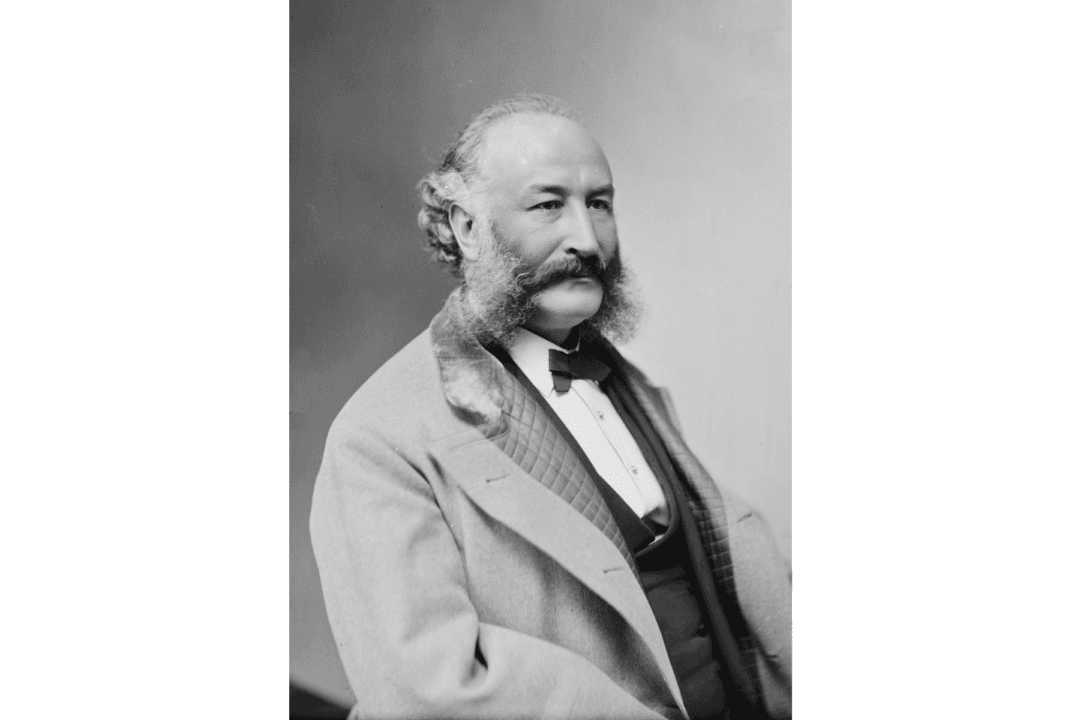A sailing vessel from England called the North Carolina arrived off the coast of Maryland. Its destination was Baltimore, but try as it might, the ship could not reach the harbor. It was surrounded by ice, and it would be two months before it could free itself and unload its passengers.
One of those passengers was the young German-born immigrant John Jacob Astor. He had boarded the vessel in November of 1783, approximately two months after the signing of the Treaty of Paris, which officially ended the war between America and Great Britain. It seemed a favorable time to depart for the New World. The only problem was the weather.
The weather, in fact, had become a problem everywhere—most notably in the northern hemisphere. On June 8, 1783, one of Iceland’s 130 volcanoes erupted. Known as the Laki event, the eruption was more than just that of the Grimsvotn volcano, though; the entire volcanic fissure called Lakagigar, extending nearly 17 miles, split open. The volcano erupted for eight months. Its column rose as high as nine miles into the sky and spewed superheated ash into the atmosphere. The fissure’s eruption stopped on Feb. 7, 1784, but the volcano’s eruption continued until May of 1785.

Grimsvotn emitted twice the amount of pyroclastic fall—the visible ash, pumice, and debris—than the 1980 eruption of Mount St. Helens. Haze reached as far as Syria. The 80 megatons of sulfuric acid aerosol emitted was 80 times more than that of St. Helens’s.
Iceland lost a fifth of its population, about 9,000 people, and a majority of its livestock. England, located just southeast of the island nation, suffered approximately 23,000 deaths related to the poisoned air. The Laki event created an unusually hot summer in 1783, resulting in crop failures and massive flooding throughout Europe. Japan experienced one of its worst famines. In North America, the weather was, in a sense, the opposite. The summer was unusually cold, and it became colder as summer turned into autumn and autumn into winter.
Astor and the Fur Trade
Astor, who had grown up in Waldorf, near Heidelberg, was the son of a butcher. By the age of 16, he moved to London to join his elder brother selling musical instruments. It was there that he learned English. After several years and having saved up enough money, he decided to join his other brother in New York City. It was during the extended stay in the frozen Chesapeake Bay that altered Astor’s career choice and American history.A fellow German, who was returning to America, informed Astor of the new country’s promising fur industry. Astor ascertained all the information he could about the work. Once the ship made port and Astor finally made his way to New York City, he met a fur trader who hired him for $2 per week.
Astor rented a room in a Manhattan boarding house run by a widow. There, he met his soon-to-be wife—the widow’s daughter, Sarah Todd. The Todds proved well-connected in New York, having come from an established Dutch family. Furthermore, Sarah was an attractive young girl with good business sense and a $300 dowry (about $10,000 today). The two were married on Sept. 19, 1785, and, by the following year, they began their fur trading business, networking with native tribes, trappers in New York and New England, and the fur auctions of Montreal—the fur-trading hub in North America. The couple also opened a musical instrument shop, associated with his brother in London.

When it came to competing in the fur trading business, one behemoth corporation dominated the industry: the Hudson’s Bay Company, chartered in 1670. At the same time, in Montreal, another fur trading company was on the rise: the North West Company, formed in 1779. Astor was invited to attend the company’s annual meeting in 1789 at Fort William on Lake Superior. The young businessman understood how far he had to go to truly compete on a grand scale. It was time to secure shipping lines to move products back and forth across the Atlantic. Doing so, however, wasn’t an easy task.

Revolution and the Jay Treaty
The Treaty of Paris of 1783, which ended the Revolutionary War, had done little to quell the negative feelings between America and Great Britain. Another revolution, however, was on the horizon, and would assist Astor’s efforts. The same year that Astor attended the North West Company meeting, the French Revolution broke out. The Laki event may have contributed to the unrest through crop failures that led to poverty and starvation. As the French revolted internally, its violence and revolutionary ideas spilled into other European countries. By 1793, the British had another revolution to quell.As the Revolution turned into the French Revolutionary Wars, the British began impressing American sailors into service for the Royal Navy. This insult added to several other problems the British had created for the Americans: the flooding of American markets with British goods, which hurt U.S. businesses; tariffs and excessive trade restrictions placed on America; and the presence of British forts in America.
The United States began rattling its sabers, despite knowing it could ill afford to go to war. In 1794, John Jay was sent to London to negotiate a treaty between the two nations. Jay’s Treaty of 1794 met with disappointment.
Napoleon and Expanding Trade
Astor’s trading network of native tribes, northeastern trappers, and businesses in Montreal, soon found a new market in London. He purchased a ship to begin exporting furs to London, including exporting for Canadian companies. By the end of the 18th century, Astor was worth approximately $250,000 (more than $6 million today).While conducting business in London in 1800, he became acutely aware of trade with China. Coincidentally, America’s first commercial vessel destined for China had left New York Harbor on Feb. 22, 1784, the same time Astor was stranded in Chesapeake Bay. Along with his growing European networks, the city of Canton (modern-day Guangzhou) was added to his trade routes. China proved a profitable fur market.

Around the same time that Astor began concocting his plan to trade in the Far East, Spain and France had signed a secret treaty called the Treaty of San Ildefonso. Spain had been in possession of the lands west of the Mississippi called Louisiana. The treaty agreement would “retrocede to the French Republic … the colony or province of Louisiana.”
Rumors swirled about the treaty, but it was not until Secretary of State James Madison acquired a copy of the treaty in November 1801 that the rumors proved true. Napoleon Bonaparte, having been in power for two years after his 1799 coup, wished to extend the French Republic into the western hemisphere, starting in Haiti, then the port of New Orleans, and then all of Louisiana. Those plans remained on hold due to the ongoing war.
While Napoleon was looking west and Astor was looking east, Great Britain, the French Republic, and the Batavian Republic (Netherlands) signed the Treaty of Amiens on March 27, 1802. Europe had secured peace, but the agreement created an opening for conflict between America and the French.
Fortuitously for the Americans, Bonaparte’s westward aspirations were short-lived as war in Europe loomed again. In January 1803, President Thomas Jefferson made two decisions regarding Louisiana: He requested that Congress sponsor an expedition to the territory, and he sent James Monroe to help Robert Livingston negotiate the purchase of Louisiana.
Overcoming Trade Restrictions
Unfortunately, Britain and France, in their attempts to wound each other’s economies, implemented trade restrictions. The economic fallout hindered America’s commercial trade, threatening the country’s ongoing stance of neutrality. Britain’s return to impressing American sailors into the Royal Navy only heightened the tension. In retaliation for these trade restrictions and impressment of Americans, Jefferson signed the Embargo Act of 1807. It was a piece of legislation that had adverse effects on the American economy.He wrote, the “intention is to carry On the trade So extensively that it may in time embrace the greater part of the fur trade on this Continent the most of which passes now through Canada—every exertion shall be made to forward the views & wishes of government in these relation with the Indians & it is believed that the trade will in time be made productive and leave advantages to the country.”
On March 29, 1808, the New York legislature provided Astor his charter. It was during this week in history, on April 6, 1808, that Astor founded the American Fur Company.
By 1834, the American Fur Company established trade depots throughout the Central and the Northern Great Plains. The company dominated the industry in America for decades, ultimately making Astor America’s first multimillionaire.









